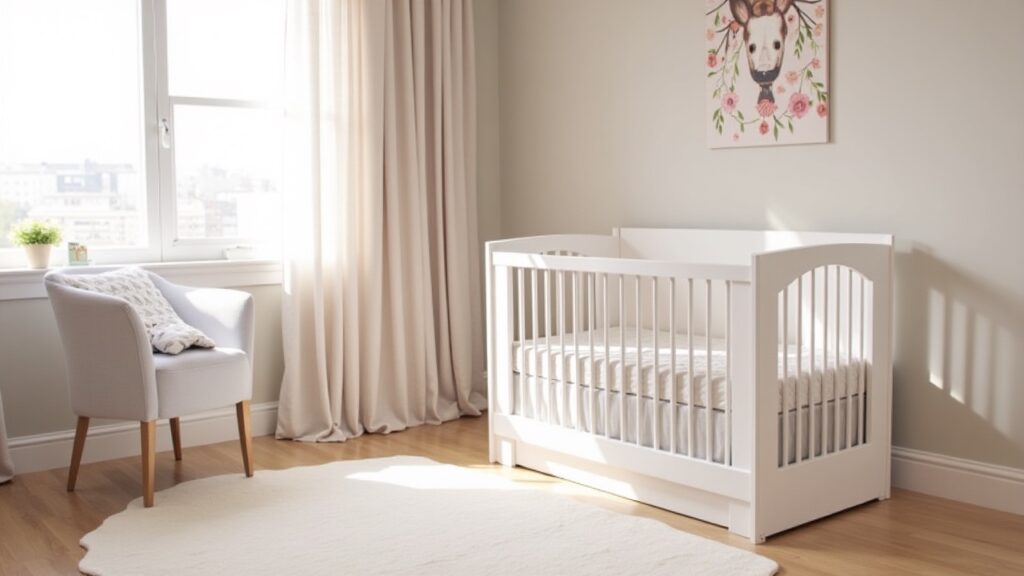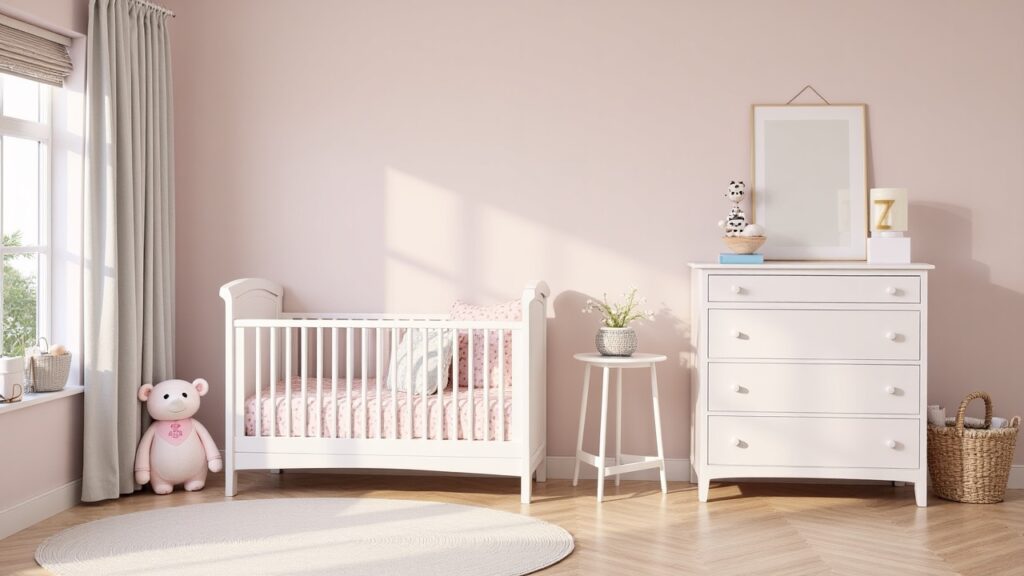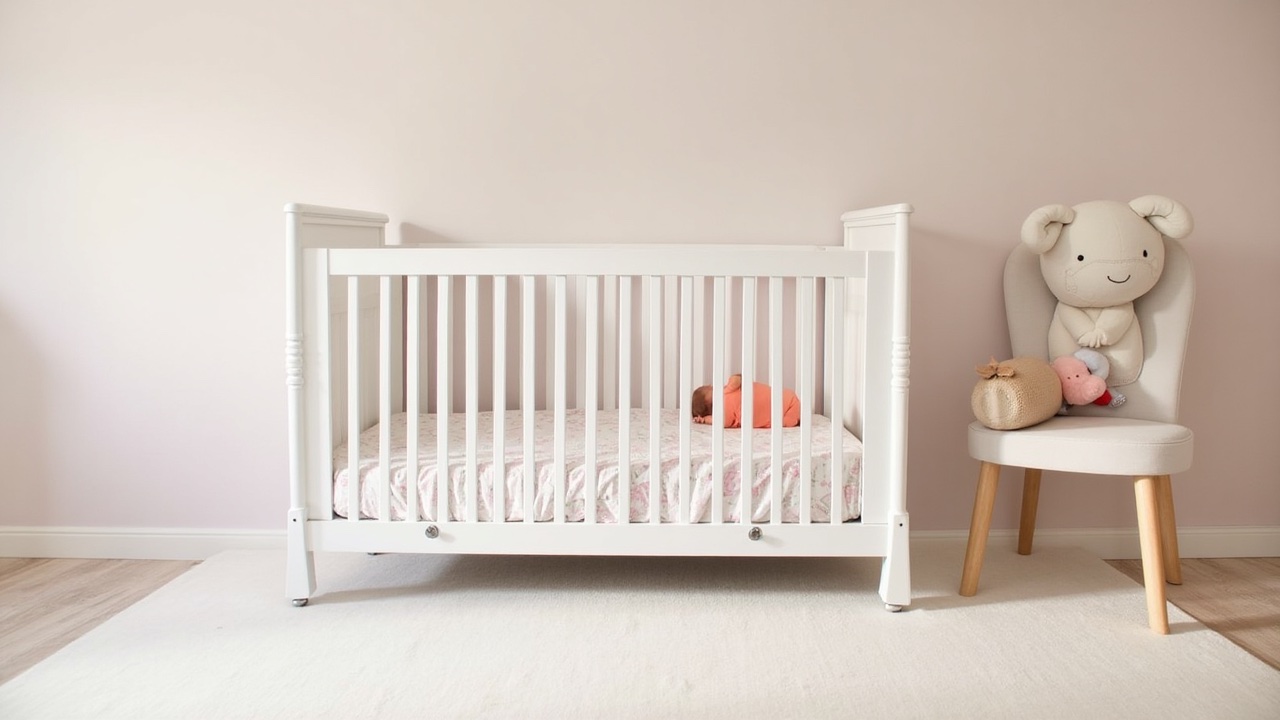Creating the perfect space for your newborn goes beyond simply choosing cute decorations and baby furniture. A well-designed nursery balances functionality with comfort, providing a peaceful environment for both baby and parents during those precious early months. The right design choices can transform even the smallest room into a haven that feels both practical and magical.
Many new parents feel overwhelmed by the endless options available for nursery design. From color schemes to furniture placement, storage solutions to lighting choices, each decision impacts how the room functions day and night. Smart planning helps create a space that works beautifully for feeding sessions, diaper changes, and those quiet moments of bonding with your little one.
Let’s explore five transformative ideas that turn ordinary rooms into extraordinary nurseries. These approaches focus on creating spaces that grow with your child while maintaining the cozy atmosphere every newborn deserves during their first months at home.
- What Makes a Newborn Space Feel Truly Cozy
- How to Create a Calming Color Palette That Grows
- Smart Storage Solutions That Hide Clutter Beautifully
- Lighting Design for Day and Night Comfort
- Furniture Placement That Maximizes Flow and Function
- Bringing It All Together for Your Perfect Haven
- Frequently Asked Questions
What Makes a Newborn Space Feel Truly Cozy

The foundation of any dreamy nursery lies in understanding what creates genuine comfort for both babies and their caregivers. Successful nursery design starts with recognizing that newborns spend most of their time sleeping, eating, and being changed, while parents need easy access to supplies and comfortable spots for feeding and soothing.
Temperature and Air Quality Control
Maintaining consistent temperature proves crucial for newborn comfort. Babies cannot regulate their body temperature effectively, making room climate a priority consideration. Position the crib away from heating vents, air conditioning units, and windows that might create drafts or temperature fluctuations.
Air purifiers designed for nurseries remove allergens and maintain fresh air circulation without creating noise that might disturb sleep. Plants like snake plants or pothos can naturally improve air quality while adding gentle greenery to the space, though they should be placed well out of reach as your baby grows.
Consider blackout curtains or shades that help maintain ideal room temperature while supporting healthy sleep patterns. These window treatments block harsh sunlight during day naps and maintain privacy during nighttime feedings.
Soft Textures and Calming Colors
Newborns respond positively to soft, muted color palettes that promote relaxation. Gentle pastels, warm neutrals, or even sophisticated grays create peaceful environments without overstimulation. Bold, bright colors can be added through easily changeable accessories like artwork or throw pillows.
Layer different textures throughout the room to create visual and tactile interest. A plush area rug underfoot, linen curtains, cotton bedding, and perhaps a knitted throw on your nursing chair all contribute to the cozy feeling you’re trying to achieve.
Lighting plays a significant role in creating atmosphere. Multiple light sources at different levels provide flexibility for various activities. A ceiling fixture offers general illumination, table lamps create warm ambient light, and a small nightlight helps with middle-of-night care without disturbing your baby’s sleep patterns.
Sound Management
Peaceful nurseries control sound rather than eliminate it completely. Newborns actually sleep better with consistent background noise that mimics the sounds they heard in the womb. A white noise machine can mask household sounds while providing comforting consistency.
Soft furnishings help absorb sound and prevent echoes in the room. Curtains, rugs, and upholstered furniture all contribute to better acoustics, creating a quieter environment for sleep and feeding.
Position the nursery away from high-traffic areas of your home when possible. If the room shares a wall with noisy spaces like the kitchen or living room, consider adding extra insulation or sound-dampening materials during your nursery preparation.
How to Create a Calming Color Palette That Grows

Selecting colors for your newborn’s room requires balancing immediate needs with long-term flexibility. The most successful nursery color schemes create a foundation that adapts as your child develops their own preferences and personality.
Starting with Neutral Foundations
Neutral wall colors provide the perfect backdrop for a nursery that can evolve over time. Soft whites, warm beiges, gentle grays, or muted sage greens create sophisticated bases that work with various accent colors and themes. These foundation shades photograph beautifully and never feel overwhelming during those long nights spent in the nursery.
Consider the room’s natural light when selecting your base color. North-facing rooms benefit from warmer neutrals like cream or soft yellow to counteract cooler natural light. South-facing rooms can handle cooler tones like pale gray or soft blue without feeling stark.
Paint quality matters significantly in nurseries. Choose low-VOC or zero-VOC paints to maintain healthy air quality for your newborn. These paints have minimal odor and off-gas fewer chemicals, creating a safer environment for your baby’s developing respiratory system.
Adding Personality Through Accents
Once your neutral foundation is established, personality comes through carefully chosen accent colors. These can be introduced through textiles, artwork, toys, and accessories that are easily changed as your child grows and develops preferences.
Soft accent colors work particularly well in newborn spaces. Dusty pink, sage green, soft lavender, or gentle yellow add warmth without overwhelming the senses. These colors photograph beautifully and create a timeless look that won’t feel dated in a few years.
Consider creating a cohesive color story by using your chosen accent color in multiple ways throughout the room. A throw pillow, picture frame, lamp shade, and storage basket in the same soft blue create visual connection without repetition.
Planning for Future Transitions
Smart color planning considers how the room will transition as your baby becomes a toddler and eventually a young child. Neutral walls can easily accommodate different themes and color preferences without requiring a complete makeover.
Here are key considerations for adaptable color schemes:
Wall Colors: Stick to neutrals that work with multiple accent colors and themes over time.
Large Furniture: Choose pieces in classic colors like white, natural wood, or soft gray that coordinate with various color schemes.
Changeable Elements: Use bedding, curtains, rugs, and artwork to introduce color and pattern that can be updated affordably.
Gender Flexibility: Even if you know your baby’s gender, consider colors that could work for future siblings who might eventually use the room.
Photography Considerations: Neutral backgrounds make it easier to capture beautiful photos of your growing child without color clashes.
The most successful nursery color schemes feel intentional yet relaxed, sophisticated yet child-friendly. They provide a peaceful environment for your newborn while offering flexibility for the years ahead.
Smart Storage Solutions That Hide Clutter Beautifully

Newborns require an surprising amount of supplies, from diapers and clothing to toys and feeding accessories. Effective storage systems keep essentials organized and accessible while maintaining the serene atmosphere every nursery needs.
Vertical Storage Maximizes Floor Space
Wall-mounted storage solutions utilize vertical space efficiently while keeping floors clear for safe movement around the nursery. Floating shelves display books and decorative items at adult eye level while providing storage for frequently used supplies.
Consider installing a pegboard system with movable hooks and small shelves. This flexible storage adapts as your needs change, accommodating everything from newborn supplies to toddler toys. Paint the pegboard to match your wall color for a custom built-in appearance.
Tall, narrow bookcases make excellent use of vertical space without overwhelming small rooms. Choose units with both open shelving for display and closed storage for hiding less attractive necessities. Position these pieces against walls where they won’t interfere with daily activities.
Hidden Storage Maintains Clean Lines
Storage ottomans serve dual purposes as seating and hidden storage. Place one near your nursing chair to store extra blankets, burp cloths, and feeding supplies. Choose styles with removable tops for easy access during those frequent middle-of-night feeding sessions.
Under-crib storage often goes unused but offers valuable space for seasonal clothing, extra bedding, or backup supplies. Rolling storage boxes on casters make accessing these items simple without disturbing a sleeping baby above.
Built-in storage benches beneath windows create charming seating areas while hiding toys, books, or clothing. If built-ins aren’t possible, freestanding window benches with lift-up seats provide similar functionality and can move to other rooms as your child grows.
Organizing Systems That Actually Work
Drawer dividers transform cluttered spaces into organized systems. Use adjustable versions in dressers to create specific spots for different clothing categories. This organization makes getting dressed easier during those sleepy morning routines.
Clear containers work wonderfully for small items like pacifiers, hair accessories, or medication. Label these containers clearly so other caregivers can quickly locate needed items, especially important during nighttime care when you want to minimize disruption.
Hanging organizers maximize closet space efficiently. Over-the-door shoe organizers with clear pockets hold everything from socks and bibs to toys and books. Inside the closet, hanging shelves add storage for folded clothes and accessories.
The key to successful nursery storage lies in creating systems that work even when you’re exhausted. Everything should have a designated home that makes sense intuitively, allowing you to maintain organization even during the chaos of new parenthood.
Lighting Design for Day and Night Comfort
Proper lighting design significantly impacts both your baby’s sleep patterns and your ability to care for them comfortably throughout the day and night. A well-lit nursery provides appropriate illumination for various activities while supporting healthy circadian rhythms.
Layered Lighting Approaches
Multiple light sources at different levels create flexibility for various nursery activities. Overhead lighting provides general illumination for playtime and room cleaning. Table and floor lamps offer gentler ambient lighting perfect for feeding sessions and bedtime routines.
Task lighting proves essential near the changing area and nursing chair. A small table lamp or wall-mounted sconce provides focused light for diaper changes and nighttime feedings without flooding the entire room with harsh brightness that might overstimulate your baby.
Decorative lighting adds warmth and personality to the space. String lights behind sheer curtains create magical ambiance, while a beautiful pendant light serves as both illumination and room focal point. Choose fixtures that complement your overall design aesthetic.
Dimmer Controls and Smart Features
Installing dimmer switches allows you to adjust lighting intensity throughout the day and night. Bright light supports active playtime and room maintenance, while dimmed lighting creates calm environments for feeding and soothing.
Smart lighting systems offer convenient control through smartphone apps. Program different lighting scenes for various activities – bright for daytime play, medium for feeding, and very dim for middle-of-night care. These systems can even gradually dim or brighten to support sleep routines.
Timer functions help establish consistent lighting patterns that support healthy sleep habits. Gradually dimming lights in the evening signals bedtime approaching, while slowly brightening morning light can help establish wake-up routines as your baby grows.
Safety and Positioning Considerations
All lighting fixtures should be positioned safely out of your baby’s reach as they grow and become mobile. Secure cords properly and choose fixtures without small parts that could pose choking hazards.
Avoid placing lamps or other lighting sources too close to the crib where curious hands might reach them. Wall-mounted fixtures often provide safer alternatives to table lamps in nurseries.
Consider the heat output of various lighting options. LED bulbs produce minimal heat and use less energy than traditional incandescent bulbs, making them safer and more economical choices for nursery use.
Natural light management also impacts nursery comfort. Blackout curtains or cellular shades help control daylight for better napping while maintaining privacy. Consider window treatments that can be adjusted to different levels of light control throughout the day.
The most effective nursery lighting schemes provide beautiful, functional illumination that adapts to your changing needs as both you and your baby adjust to life together.
Furniture Placement That Maximizes Flow and Function
Strategic furniture arrangement creates efficient traffic patterns while maintaining the cozy atmosphere essential for newborn comfort. Thoughtful placement considers both daily routines and safety as your baby grows and becomes mobile.
Creating Functional Zones
Divide your nursery into specific activity zones to maximize efficiency and organization. The sleeping zone centers around the crib with easy access from multiple directions. Position this area away from doors and high-traffic paths to minimize sleep disruptions.
Establish a feeding zone with comfortable seating, good lighting, and nearby storage for supplies. Your nursing chair should offer proper back support and armrests at comfortable heights. Include a small side table for water, books, or your phone during long feeding sessions.
The changing zone requires easy access to supplies and appropriate lighting for safety. Position the changing table against a wall for stability, with storage shelves or caddies within arm’s reach. This area should connect easily to other zones without requiring trips across the room.
Traffic Flow and Safety Planning
Plan clear pathways between important areas of the room. You’ll frequently move between the crib and changing area, often while carrying your baby. Remove obstacles and position furniture to create wide, unobstructed paths for safe navigation, especially during nighttime visits.
Consider door placement when arranging furniture. Avoid blocking the entrance or creating furniture arrangements that make the door difficult to open fully. Emergency access should remain clear at all times.
As your baby becomes mobile, current furniture placement will need reconsideration. Plan arrangements that can adapt to childproofing needs. Heavy furniture should be secured to walls, and sharp corners may need padding or repositioning.
Making Small Spaces Work Harder
Compact nurseries require creative furniture placement to accomplish everything needed in limited square footage. Multi-functional pieces serve multiple purposes without crowding the space. A dresser topped with a changing pad eliminates the need for a separate changing table.
Corner placement utilizes often-wasted space effectively. A comfortable chair positioned in a corner creates a cozy feeding nook while leaving more floor area open. Corner shelving units provide storage without interrupting traffic flow.
Consider the visual weight of furniture pieces and their impact on perceived room size. Light-colored furniture appears less bulky than dark pieces. Pieces with legs create a sense of openness compared to solid, ground-sitting furniture.
Mirrors strategically placed can make small nurseries feel larger and brighter. Position mirrors to reflect natural light or beautiful views rather than creating confusing reflections that might overstimulate your baby.
The most successful nursery layouts feel both organized and relaxed, supporting your daily routines while creating a peaceful environment for your growing family.
Bringing It All Together for Your Perfect Haven
Creating a dreamy newborn room combines practical planning with personal touches that reflect your family’s style and needs. The most successful nurseries balance beauty with functionality, resulting in spaces that work beautifully for both daily care routines and those precious quiet moments with your little one.
Your nursery will evolve as your baby grows and your family’s needs change. The foundation elements – quality furniture, flexible storage, and good lighting – provide the structure for a room that adapts over time. Personal touches through color, texture, and decorative elements can be updated affordably as your child develops their own personality and preferences.
Focus on creating a space that feels right for your family rather than copying trends or magazine photos exactly. Trust your instincts about what will work best for your daily routines and lifestyle. The perfect nursery is one that supports your growing family while creating beautiful memories during those fleeting newborn days.
Frequently Asked Questions
Q: How early should I start setting up the nursery?
A: Most parents begin nursery setup during the second trimester, around 20-24 weeks. This timing allows plenty of preparation time while avoiding the physical challenges of late pregnancy.
Q: What’s the most important furniture piece to invest in?
A: A comfortable nursing chair with proper support makes the biggest difference in daily comfort. You’ll spend many hours feeding and soothing your baby, making this investment worthwhile.
Q: How can I make a small nursery feel larger?
A: Use light colors, maximize vertical storage, choose furniture with legs, and add mirrors to reflect natural light. Keeping floors clear also creates a sense of openness.
Q: Should I choose a theme for the nursery?
A: Themes can be fun but aren’t necessary. Focus on creating a cohesive color palette and comfortable environment. Simple, timeless designs typically age better than trendy themes.
Q: What lighting is safest for newborns?
A: Multiple light sources with dimmer controls work best. Avoid harsh overhead lighting and choose LED bulbs for safety and energy efficiency. Position all fixtures out of baby’s eventual reach.
Q: How much storage do I really need?
A: More than you expect. Babies accumulate supplies quickly. Plan for clothes in multiple sizes, diapers, feeding supplies, toys, and seasonal items. Vertical storage maximizes space efficiently.
Q: When should I baby-proof the nursery?
A: Start baby-proofing around 6 months, before your baby becomes mobile. Secure furniture to walls, cover outlets, and remove or secure any potential hazards within reach.
Q: Can I use regular household furniture in the nursery?
A: Yes, many regular furniture pieces work well. Ensure all items are stable, secure, and free from sharp edges or small parts that could pose safety risks.
Q: How do I maintain good air quality in the nursery?
A: Use low-VOC paints, maintain proper ventilation, consider an air purifier, and add safe plants if desired. Keep the room clean and dust-free for optimal air quality.

